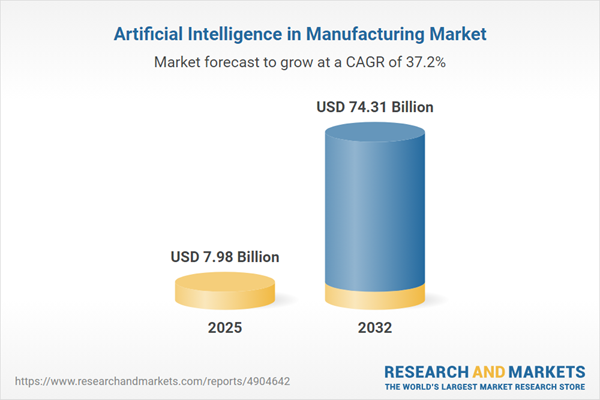Speak directly to the analyst to clarify any post sales queries you may have.
Artificial intelligence is reshaping manufacturing by enabling greater agility, efficiency, and proactive decision-making. As transformation accelerates, manufacturing leaders are leveraging advanced technologies to stay competitive, adapt to regulatory shifts, and ensure operational resilience.
Market Snapshot: Artificial Intelligence in Manufacturing
The global artificial intelligence in manufacturing market reached USD 5.91 billion in 2024 and is expected to rise to USD 7.98 billion by 2025. This significant growth is being driven by ongoing digital transformation initiatives, increasing adoption of digital twin technologies, scalable automation, and integration of edge-based analytics. Manufacturing organizations are implementing advanced analytical systems and machine intelligence to reinforce continuity and align with evolving regulatory demands. With AI tools, manufacturers seek to enhance resource management, rapidly detect market trends, and support compliance as industry dynamics shift. These priorities underscore AI’s role as a core competitive asset for manufacturers globally.
Scope & Segmentation: Artificial Intelligence Market Structure
- AI Types: Assisted, augmented, and autonomous AI systems streamline production processes, enhance real-time decision-making, and drive consistent quality control across all manufacturing stages.
- Offerings: Hardware solutions—such as GPUs, FPGAs, and microprocessors—combined with analytics software and digital platforms, modernize plant operations while enabling secure, scalable integration across environments.
- Technologies: Machine learning, computer vision, context-aware computing, and natural language processing are key technologies that help unlock actionable insights from data and empower fast response to operational inefficiencies.
- Applications: Predictive maintenance, automated defect detection, demand forecasting, production planning, and logistics optimization are critical use cases, supporting continuity and efficiency while helping mitigate supply and demand fluctuations.
- Industry Verticals: Key sectors—automotive, electronics, pharmaceuticals, food and beverage, and energy—are adopting AI to better comply with regulations, improve product quality, and enable uninterrupted production cycles.
- Regions: The Americas maintain lead positions in AI innovation and investment; EMEA markets prioritize varied deployment strategies; Asia-Pacific demonstrates rapid adoption through regulatory flexibility and targeted technology investment.
- Leading Companies: Manufacturers leverage solutions from Nvidia, Siemens, ABB, Cisco, IBM, Microsoft, Rockwell Automation, and Mitsubishi Electric to address operational challenges and support end-to-end digital transformation.
Key Takeaways for Senior Decision-Makers
- Embedding artificial intelligence in operations improves organizational agility, enabling faster adaptation to shifting market conditions and supply chain disruptions.
- Applying computer vision technologies enhances quality assurance and streamlines compliance with sector-specific regulations, especially for industries with stringent oversight.
- Encouraging collaboration between engineering and data science teams supports ongoing innovation and drives continuous improvement throughout manufacturing processes.
- Utilizing digital twin and generative design solutions optimizes resource allocation, strengthening adaptability to regulatory requirements and market volatility.
- Implementing robust AI enablement strategies—including comprehensive project oversight, workforce upskilling, and governance—ensures lasting value and advances operational sustainability.
- Adopting open platforms and pursuing strategic partnerships facilitates scalable AI deployment and drives enhanced collaboration across the broader supply chain.
Tariff Impact: Navigating 2025 Regulatory Shifts
New US tariffs affecting AI-enabled supply chains are prompting manufacturers to re-evaluate sourcing models, including increased focus on near-shoring to mitigate operational risks. Navigating this changing regulatory landscape requires robust risk management strategies, reassessment of supplier relationships, and logistics initiatives to maintain supply stability. Distributed production networks, adaptable contract frameworks, and clear compliance mechanisms help support readiness. Ongoing investment in skills development builds organizational capacity for sustained adaptation.
Methodology & Data Sources
This report synthesizes insights from industry surveys, regulatory analyses, executive interviews, and proprietary data sets. Academic research is used to validate findings and provide senior leaders with credible guidance for integrating artificial intelligence into their manufacturing operations.
Why This Report Matters
- Supports executive planning for AI investments and ensures alignment with changing operational and market needs.
- Delivers in-depth analysis of current regulatory developments to help manufacturers reinforce risk mitigation and enhance supply chain resilience.
- Provides actionable frameworks to drive operational efficiency and sustain robust business models in a complex manufacturing landscape.
Conclusion
Artificial intelligence is a pivotal enabler of manufacturing innovation and adaptability. Strategic adoption equips industry leaders to strengthen operational resilience and maintain long-term competitive positioning as sector dynamics continue to evolve.
Additional Product Information:
- Purchase of this report includes 1 year online access with quarterly updates.
- This report can be updated on request. Please contact our Customer Experience team using the Ask a Question widget on our website.
Table of Contents
3. Executive Summary
4. Market Overview
7. Cumulative Impact of Artificial Intelligence 2025
Companies Mentioned
The companies profiled in this Artificial Intelligence in Manufacturing market report include:- Nvidia Corporation
- Siemens AG
- ABB Ltd.
- Advanced Micro Devices, Inc.
- AIBrain Inc.
- Bright Machines, Inc.
- Cisco Systems, Inc.
- Cognex Corporation
- Dassault Systèmes SE
- Emerson Electric Co.
- Fanuc Corporation
- ForwardX Technology Co., Ltd.
- General Electric Company
- General Vision Inc.
- Google, LLC by Alphabet Inc.
- Graphcore Limited
- Hewlett Packard Enterprise Company
- Hitachi, Ltd.
- Honeywell International Inc.
- Intel Corporation
- International Business Machines Corporation
- Keyence Corporation
- Landing AI
- Medtronic PLC
- Micron Technology Inc.
- Microsoft Corporation
- Mitsubishi Electric Corporation
- Novartis International AG
- Oracle Corporation
- Path Robotics
- Progress Software Corporation
- Rockwell Automation Inc.
- SAP SE
- SparkCognition, Inc.
- UBTECH Robotics, Inc.
- Yaskawa Electric Corporation
Table Information
| Report Attribute | Details |
|---|---|
| No. of Pages | 190 |
| Published | October 2025 |
| Forecast Period | 2025 - 2032 |
| Estimated Market Value ( USD | $ 7.98 Billion |
| Forecasted Market Value ( USD | $ 74.31 Billion |
| Compound Annual Growth Rate | 37.1% |
| Regions Covered | Global |
| No. of Companies Mentioned | 37 |









